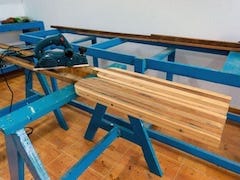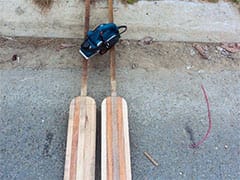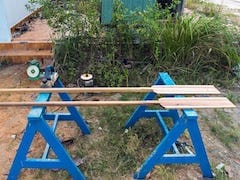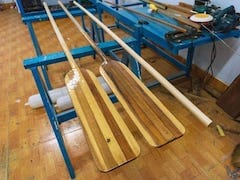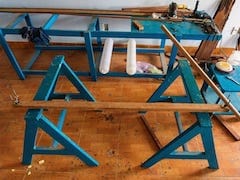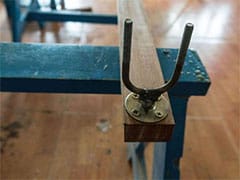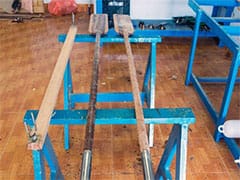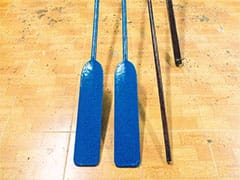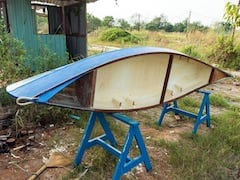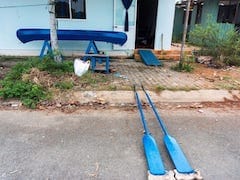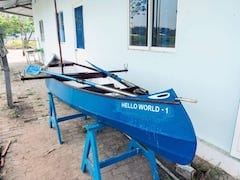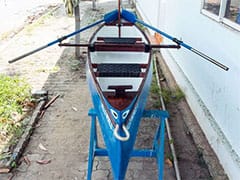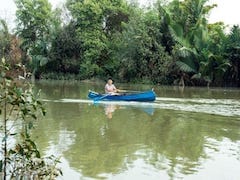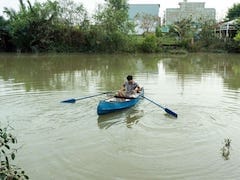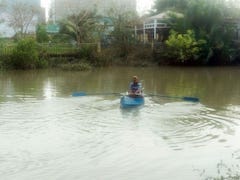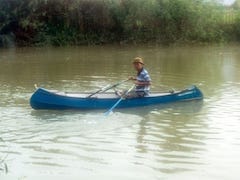Boating progress has been stagnated lately… But really I’m interested in experimenting with rowing, another way of propelling the boat besides paddling. Rowing can help building other groups of your muscles, it could produce more torque to push the canoe forward under unfavourable wind and current conditions, it should increase sustainable speed significantly, furthermore, it’s good for long – range tandem trips: with two hands aboard, ones can take turn to row and to rest. First, I make a pair of 8 feet oars: 5 planks of wood is glued and screwed together to form the oar’s handle and blade. Next is scraping and planing them into their final shapes using my new, very useful tool: a power planer. Then the 4 feet 8 inches outrigger and flotations.
For the oars, I use a lighter wood, Vietnamese name: thao lao (Lagerstroemia calyculata Kurz); the white, fine grain wood traditionally used for building paddle, oar and rudder. Having density at about 0.9 (900 kg/m3), the wood is not as heavy and hard as căm xe (Xylia xylocarpa), but resists better to water. The oars handles’ ends would be attached with short aluminium tubes, which serve two purposes: 1. lengthen the oars to the full length of 2.4m (8 feet) and 2. the hollow tubes will be casted with about 1.5kg of lead each, to better balance the oars once they’re put onto the oarlocks, and hence reduce rowing effort. I’d also decided to use ready – made plastic fishing buoys for flotations, to make the outrigger construction simpler and easier.
Today, I took Hello World – 1 to dry dock for inspection, maintenance and more fitting. After almost 2 months on open water and under direct sunlight, mistakes in the building phase have been shown: 2, 3 small cracks on the outer fiberglass and epoxy layer at bottom aft, water has leaked into the aft watertight compartment (about a gallon), and the paint has been scratched at places… Also, I should have taken more care on the canoe’s storage and usage. Now I need to make some repairs: find the seal the leaks, repaint some small areas, lower the seats to improve stability, before being able to fit the rowing kit and other miscellaneous accessories: cleat and anchor, the light pole… It could take the next 2, 3 days to finish all these things!
Today, we tested the preliminary rowing kit, the result is very unsatisfactory, but somewhat encouraging still. I’ll need to rethink about the designs, various flaws are spotted and to be rectified: the oars are too long and heavy, the oar locks are placed too low that they limit the rowing movements, flotations are not done yet… The only promising thing is that speed would surely get a huge improve, we was expecting to be able to sustain somewhere around 4, 5 knots (7 ~ 9 km/h), a great advantage (compared to paddling) for long – range cruising. But that would be the jobs of the coming (Lunar) new year, for now, all boating works will be temporarily suspended, as I’ve already got in my TODO list many other stuffs which have higher priority.

